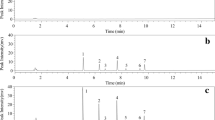Abstract
A comprehensive and accurate determination of free fatty acids (FFA) is required for fecal metabolomic investigations. The present study compares three aqueous extraction methods (1) ULTRA-TURRAX®, (2) whirl mixing and (3) basic ULTRA-TURRAX extraction of fecal FFA with a direct derivatization approach using ethyl chloroformate as the derivatization reagent before determination by gas chromatography–mass spectrometry. The direct derivatization method resulted in significantly higher estimations (P < 0.01) of short- and long-chain fatty acids than was the case when applying the aqueous extraction methods using ULTRA-TURRAX, whirl mixing, or basic ULTRA-TURRAX extraction before the derivatization step. Thus, avoiding an aqueous extraction before derivatization reduces the loss of volatile short-chain FFA and the less water-soluble long-chain FFA.



Similar content being viewed by others
Abbreviations
- BCFAA:
-
Branched chain free amino acids
- ECF:
-
Ethyl chloroformate
- FFA:
-
Free fatty acids
- GC:
-
Gas chromatography
- GC–MS:
-
Gas chromatography–mass spectrometry
- LCFFA:
-
Long chain free fatty acids
- RSD:
-
Relative standard deviation
- SCFFA:
-
Short chain free fatty acids
- SIM:
-
Single ion monitoring
References
Macfarlane S, Macfarlane GT (2003) Regulation of short-chain fatty acid production. Proc Nutr Soc 62:67–72
Brahe LK, Astrup A, Larsen LH (2013) Is butyrate the link between diet, intestinal microbiota and obesity-related metabolic diseases? Obes Rev 14:950–959
Viladomiu M, Hontecillas R, Yuan L, Lu P, Bassaganya-Riera J (2013) Nutritional protective mechanisms against gut inflammation. J Nutr Biochem 24:929–939
Jacobsen R, Lorenzen JK, Toubro S, Krog-Mikkelsen I, Astrup A (2005) Effect of short-term high dietary calcium intake on 24-h energy expenditure, fat oxidation, and fecal fat excretion. Int J Obes (Lond) 29:292–301
Verkade HJ, Hoving EB, Muskiet FA, Martini IA, Jansen G, Okken A, Vonk RJ, Bijleveld CM (1991) Fat absorption in neonates: comparison of long-chain-fatty-acid and triglyceride compositions of formula, feces, and blood. Am J Clin Nutr 53:643–651
Ng JS, Ryan U, Trengove RD, Maker GL (2012) Development of an untargeted metabolomics method for the analysis of human faecal samples using Cryptosporidium-infected samples. Mol Biochem Parasitol 185:145–150
Zheng X, Qiu Y, Zhong W, Baxter S, Su M, Li Q, Xie G, Ore BM, Qiao S, Spencer MD et al (2013) A targeted metabolomic protocol for short-chain fatty acids and branched-chain amino acids. Metabolomics 9:818–827
Weir TL, Manter DK, Sheflin AM, Barnett BA, Heuberger AL, Ryan EP (2013) Stool microbiome and metabolome differences between colorectal cancer patients and healthy adults. PLoS ONE 8:e70803
Phua LC, Koh PK, Cheah PY, Ho HK, Chan EC (2013) Global gas chromatography/time-of-flight mass spectrometry (GC/TOFMS)-based metabonomic profiling of lyophilized human feces. J Chromatogr B Analyt Technol Biomed Life Sci 937:103–113
Zhao G, Nyman M, Jonsson JA (2006) Rapid determination of short-chain fatty acids in colonic contents and faeces of humans and rats by acidified water-extraction and direct-injection gas chromatography. Biomed Chromatogr 20:674–682
Gao X, Pujos-Guillot E, Martin JF, Galan P, Juste C, Jia W, Sebedio JL (2009) Metabolite analysis of human fecal water by gas chromatography/mass spectrometry with ethyl chloroformate derivatization. Anal Biochem 393:163–175
Garner CE, Smith S, de Lacy Costello B, White P, Spencer R, Probert CS, Ratcliffe NM (2007) de Lacy Costello B, White P, Spencer R, Probert CS, Ratcliffe NM: volatile organic compounds from feces and their potential for diagnosis of gastrointestinal disease. Faseb J 21:1675–1688
Qiu Y, Su M, Liu Y, Chen M, Gu J, Zhang J, Jia W (2007) Application of ethyl chloroformate derivatization for gas chromatography-mass spectrometry based metabonomic profiling. Anal Chim Acta 583:277–283
Amer B, Nebel C, Bertram HC, Mortensen G, Hermansen K, Dalsgaard TK (2013) Novel method for quantification of individual free fatty acids in milk using an in-solution derivatisation approach and gas chromatography–mass spectrometry. Int Dairy J 32:199–203
van de Merbel NC (2008) Quantitative determination of endogenous compounds in biological samples using chromatographic techniques. Trends Anal Chem 27:924–933
Tao X, Liu Y, Wang Y, Qiu Y, Lin J, Zhao A, Su M, Jia W (2008) GC-MS with ethyl chloroformate derivatization for comprehensive analysis of metabolites in serum and its application to human uremia. Anal Bioanal Chem 391:2881–2889
Kvitvang HF, Andreassen T, Adam T, Villas-Boas SG, Bruheim P (2011) Highly sensitive GC/MS/MS method for quantitation of amino and nonamino organic acids. Anal Chem 83:2705–2711
Soerensen KV, Thorning TK, Astrup A, Kristensen M, Lorenzen JK (2014) Effect of dairy calcium from cheese and milk on fecal fat excretion, blood lipids, and appetite in young men. Am J Clin Nutr 99:984–991
Mattijssen F, Alex S, Swarts HJ, Groen AK, van Schothorst EM, Kersten S (2014) Angptl4 serves as an endogenous inhibitor of intestinal lipid digestion. Mol Metabolism 3:135–144
Ahmed I, Greenwood R, Costello BdL, Ratcliffe NM, Probert CS (2013) An investigation of fecal volatile organic metabolites in irritable bowel syndrome. PLoS One 8:e58204
Acknowledgments
The Danish Council for Strategic Research, the Danish Dairy Research Foundation, and Arla Foods are acknowledged for their financial support through the two projects ‘DairyHealth - Dairy lipids, proteins and the metabolic syndrome’ (Journal Number 10-093497) and ‘FIAF - Milk in regulating lipid metabolism and overweight. Uncovering milk’s ability to increase expression and activity of fasting-induced adipose factor’ (Journal Number 10-093539).
Author information
Authors and Affiliations
Corresponding author
About this article
Cite this article
Amer, B., Nebel, C., Bertram, H.C. et al. Direct Derivatization vs Aqueous Extraction Methods of Fecal Free Fatty Acids for GC–MS Analysis. Lipids 50, 681–689 (2015). https://doi.org/10.1007/s11745-015-4029-5
Received:
Accepted:
Published:
Issue Date:
DOI: https://doi.org/10.1007/s11745-015-4029-5




